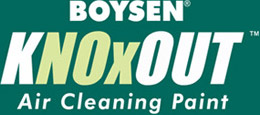April 16, 2010

An act of kindness to nature means an act of health to humans, as well. By properly maintaining our vehicles and properly operating it, we not only help reduce greenhouse gas and toxic fumes emissions, we help keep our lungs healthy, as well. And if the latest paint technologies help in reducing even further the emissions from motor vehicles, so much the better for man, woman and Nature.
This was what former Environment Secretary and now Earth Day Network Chair Elisea Bebet Gozun explained to Inquirer Health during a recent anti-air pollution drive in Makati City called OneWallOneWorld.
The OneWallOneWorld initiative in Makati featured the ceremonial repaint of walls initially across the Makati Parks and Garden, Bonifacio Monument (on Lawton Avenue in Barangay Cembo covering the roadside from J.P. Rizal to Kalayaan going to Gate One) using BOYSEN® KNOxOUT™ which can filter eight cars’ worth of emissions per square meter.
Proactive measure
About 800,000 cars pass through Makati City on a daily basis.
This initiative is just one among many proactive measures government and private sectors are adopting to address the perennial problem of air pollution in the country’s urban centers, particularly in Metro Manila. Gozun is already optimistic at this stage, comparing the country's particulate content in 1991 and 1992 which was five times the standard with the present particulate content which is now just double the standard.
“We’re really calling on everybody to get involved,” Gozun urged.
Dr. Encarnita Blanco Limpin of the Philippine College of Chest Physicians related that, based on her clinical experience, respiratory problems due to air pollution arose not just from exposure to smog from automobiles or factories, but from smoking as well, whether the victim is the smoker himself or inhaling secondhand smoke.
“Smoking is a major cause of indoor air pollution and a major portion of our daily lives are spent indoors,” she quipped.
Other medical experts have concurred that smoking and/or inhaling secondhand smoke are the most common causes of Chronic Obstructive Pulmonary Disease. The experts also added that other kinds of lung irritants, such as pollutants from vehicle exhausts as well as dust or chemicals from work areas may also contribute to COPD.
Primary victims
Limpin singled out street sweepers, traffic enforcers and toll gate operators as the primary victims of respiratory problems. She stressed that jeepney drivers’ respiratory problems are caused by both exposure to cigarette smoking and inhalation of vehicular exhausts.
Of the total number of TB victims included in the World Bank environment report for 2002 (based on the study conducted by the UP College of Public Health), COPD showed the most prevalence at 32.5 percent among jeepney drivers.
Bus drivers, despite staying most of the time inside their air-conditioned vehicles, came in second at 16.4 percent, while commuters were third at 14.8 percent.
Respondents afflicted with pulmonary TB, the worst stage of the pulmonary disease, were also mostly comprised of jeepney drivers (17.5 percent).
The study involved jeepney drivers who had worked for an average of 14.5 years, air-conditioned bus drivers for 10 years, and commuters for 8.6 years.
Danny Villas, head of the Department of Environment Sanitation, shared that Makati’s participation in the OneWall-OneWorld advocacy is a spin-off of the city’s “Green Walls” initiative, a project that sought to repaint the walls along some of Makati’s busiest streets. But what was initially a city beautification project evolved into a major movement to fight air pollution when OneWallOneWorld came about, and the air-cleaning properties of KNOxOUT™ was introduced to the public.
Gozun is also pushing for the “biodigester” to help eliminate greenhouse gas emissions (primarily methane) from slaughterhouses and cattle farms. “Anything that rots, or biodegrades, produces methane during the process. Instead of allowing the methane to get released into the air, you can (capture it using the biodigester) and use it for lighting or for cooking,” she explained.
Meanwhile, the Livestock and Climate Change report of the WorldWatch.org which Inquirer Health was able to obtain cited the United Nations Food and Agriculture Organization which showed 37 percent of human-induced methane came from livestock (pigs, cows, chickens). Although methane warms the atmosphere much more strongly than does CO2, its half-life lasts only about 8 years, versus at least 100 years for CO2. As a result, a significant reduction in livestock raised worldwide would reduce greenhouse gases relatively quickly compared with measures involving renewable energy and energy efficiency.
Land
The report also said that as there is now a global shortage of grassland, practically the only way more livestock and feed can be produced is by destroying natural forest. Growth in markets for livestock products is greatest in developing countries where rainforest normally stores at least 200 tons of carbon per hectare. Where forest is replaced by moderately degraded grassland, the tonnage of carbon stored per hectare is reduced to just eight.
The OneWallOneWorld campaign is initiated by the Makati City government, the Clean Air Initiative for Asian Cities, the Partnership for Clean Air and the Philippine College of Chest Physicians.
- Tessa Salazar, Courtesy of The Philippine Daily Inquirer




